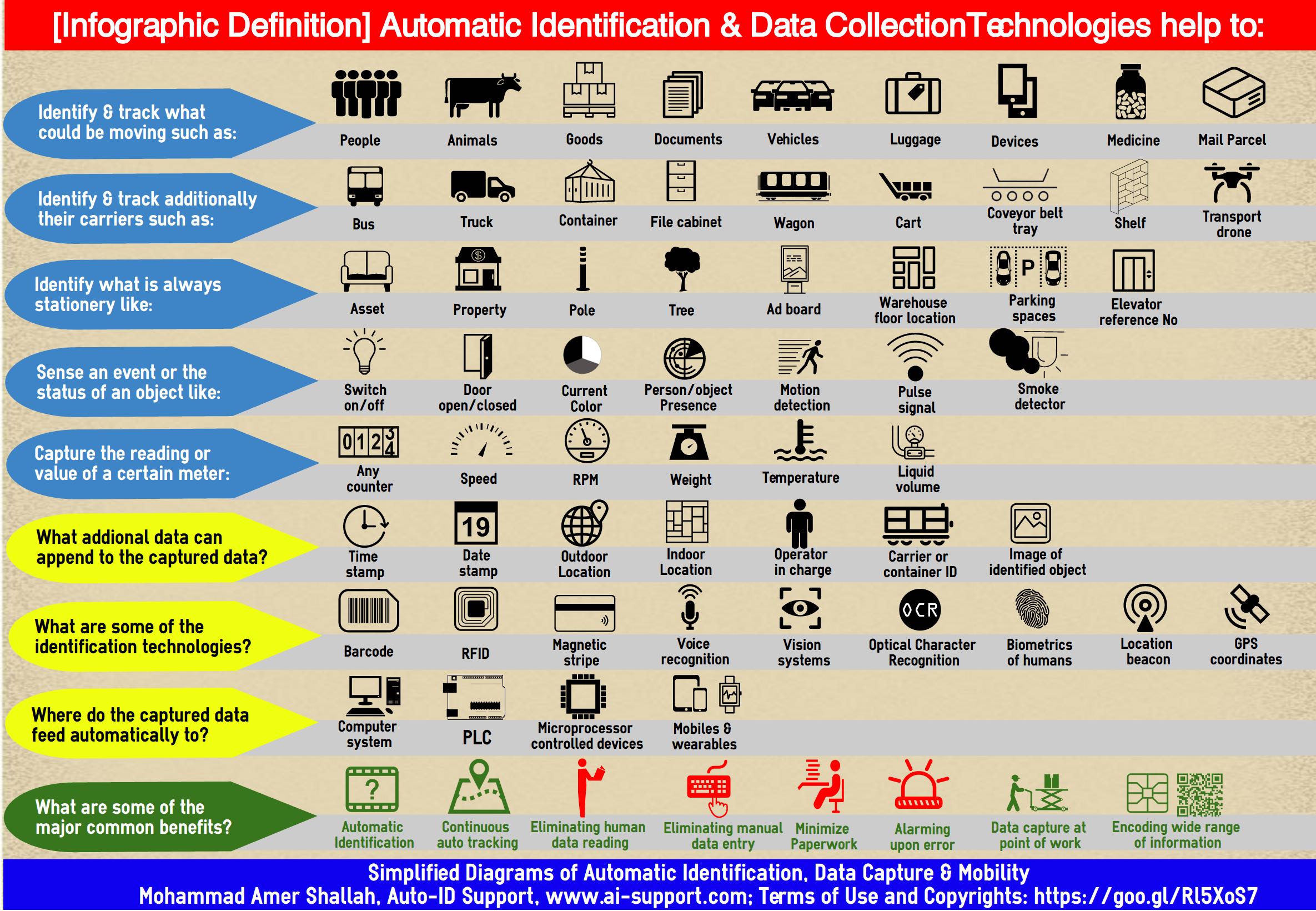The [Infographic] Definition of Automatic Identification & Data Collection Technologies
This diagram lays out the definition of Automatic Identification & Data Collection Technologies (AIDC) in an infographic form inspired mainly from the definition set by the industry association AIM’s.

To download infographic(s) at better printing resolution or share it, click: https://goo.gl/Wj9Ele
What is AIDC according to AIM?
Automatic Identification and Data Collection (AIDC) are the terms used to describe direct entry of data into a computer system, programmable logic controller (PLC) or other microprocessor-controlled device without using a keyboard. AIDC technologies provide a reliable means not only to identify but also to track items. It is possible to encode a wide range of information, from basic item or person identification to comprehensive details about the item or person.
AIDC includes a number of technologies which provide different solutions to data collection problems. These include: Bar Code, Radio Frequency Identification (RFID) and Data Communications, Magnetic Stripe, Voice and Vision Systems, Optical Character Recognition, Biometrics, as well as others. Each of the AIDC technologies has specific advantages and features which make it better suited for some applications than others. However, whether the need is to identify and track file folders on a lawyer's desk, shipping containers on a conveyor moving at 250 feet per minute, or rail cars travelling at 60 miles per hour, in all probability there is an AIDC solution for your specific application. AIDC technologies eliminate two error-prone and time-consuming activities: manual data collection and data entry. AIDC bypasses these two steps, providing a quick, accurate, and cost-effective way to collect and enter data.
For every paragraph above, there is somehow a line reflecting it in a graphical and exemplified manner. However, there are the following additions:
- Categorizing identified objects as whether they are steady or possibly moving.
- Focusing on the carriers of identified objects that move collectively (such as file cabinet carrying documents inside). Each carrier should be labeled and identified as well as its contents.
- Focusing on the data collection of meter/gauge readings or the status after identifying the objects.
- Considering that any captured data or identified object could have more data attached to it in the same database record, such as adding time stamps as to when it happened or collected.
- The benefits of AIDC are too many to list. It depends on the system functions and features.
The diagram lists some of the main technologies of identifications but does not list the devices used for the purpose, such as:
- Barcode scanners
- Handheld terminals,
- Magnetic Card readers
- RFID readers, fixed and portable
- Digital Signage
- Vehicle blackboxes
- GPS tracker
- Etc.
After identifying and data capturing, data is verified, transmitted, stored, analysed and published internally or publicly. This can be expressed in the former diagram of The General Process of AIDC Systems where more benefits are listed.
Any Partially-Automatic AIDC?
According the above definition, “AIDC technologies eliminate two error-prone and time-consuming activities: manual data collection and data entry”. There are many cases where it is not fully automatic. Here are two examples:
- A user is using a PDA for scanning barcodes of goods on the shelf for inventory. He can scan the item codes automatically but he has to count and to enter the quantity of the items manually.
- Any web form filled by customers to a supplier has the customers entering most of the data manually while the supplier gets all the data ready with nothing to enter at its side. This is quite common also in kiosks and digital signage forms.
The audience of this diagram:
- AIDC specialists who train, explain and sell these technologies to their teams.
- Any prospect who has no idea about these technologies before.
- Any specialized business or service domain that can extract from the diagram what fits its needs such as considering AIDC Technologies in Airports. As an example. It would list tracking travellers, the passports and their luggage.
Conclusions:
AIM definition can be phrased simply as “Tell me electronically, precisely, and instantaneously What, When, Where, Who, Which, How, How Much/many.” And, in many cases you can add also “Remotely and securely.”
It should be noted that AIDC technologies are advancing and expanding rapidly and are the cornerstone for any digital transformation, smart cities, big data and/or building the Internet of Things.
About myself and my writings:
I have been implementing automatic identification, data capture technologies, and mobility for 20 years in domains of business, government and security. The accumulated experience and continuous follow up on latest emerging technologies help me to contribute writings about current trends and highlight challenges. I try to bring up diagrams and infographics along each topic to clarify concepts in a simple way. I welcome all comments.
Mohammad Amer Shallah, Auto-ID Support, www.ai-support.com
Terms of Use and Copyrights: http://bit.ly/2mj2ZUj
Facebook page: www.facebook.com/aidc.diagrams
---
Other Barcode articles of interest:
